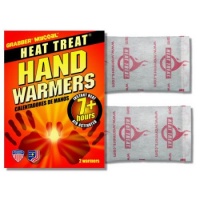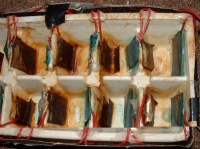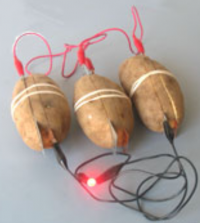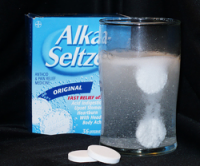These are examples of chemical devices that may be used in the Mission Possible event.
Endothermic Reactions
Ammonium Chloride and Water
Ammonium Chloride and Water
Exothermic Reactions
Oxidizing Iron
 Winter glove warming packets |
These one-use packets oxidize iron filings to produce heat.
|
Gas Producing Reactions
Vinegar and Baking Soda
|
The classic elementary science project volcano components. Mix vinegar and baking soda to generate carbon dioxide gas.
|
Alka Seltzer and Water
|
A spin on the baking soda reaction, but both components are actually in the seltzer and the water is just releasing them. Using vinegar may speed up the reaction, as will powdering the tablets.
|
Mentos and Coke
 Mixing mentos in diet coke = rapid gas expansion |
Potentially much more dramatic than other gas producing reactions. Either use small quantities, contain it well, or both. If anything leaves the boundaries of the machine, you will be penalized.
|
Precipitation Reactions
Ferric Chloride and Washing Soda
|
Ferric chloride you will have to order from online or beg some off of a chemistry teacher. Washing soda you can pick up at the supermarket. Dissolve both components in water to get a quick, dependable reaction.
|
Electricity Producing Reactions
Vinegar Battery
 Vinegar can be used with copper and zinc metal plates to generate electricity |
Vinegar (or another acid, but a strong one is not necessary and will just dissolve your plates) will react with two metals (like copper and zinc, check online for other combinations) to provide a small voltage and current. And ice cube tray is a simple way to have many small cells that can be wired in series, parallel, or both. Expect to power a small LED or a small relay.
|
Potato / Lemon Battery
 A standard potato battery |
A number of foods can be used with two different metal probes to generate a little power. Expect to power a small LED or a small relay. Galvanized nails are covered in zinc, so they will work along side copper wire.
|
Chemiluminescent Reactions
Luminol
Glowsticks can be opened and the chemicals seperated for later use. Luminol is sometimes contained.
Cut the top off of the stick and pour the liquid inside into an opaque container. Carefully extract the glass tube inside the plastic glowstick tube. Put the glass tube in another opaque bottle. If you break the glass inside the bottle then you can just use a syringe or pipet to extract the chemical. Combine the two chemicals in your machine to generate light. Use opaque containers and do not open the glowstick packaging until necessary because some of the chemicals may photodegrade, rendering them weak or useless. Some of the chemicals also stain in interesting and permanent colors.








